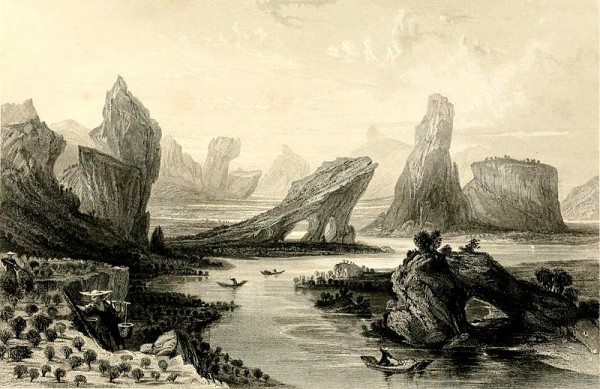Another Oolong makes the list! At number 9, Wuyi Rock Oolong originates in Fujian province as does Tie Guan Yin, but from the other side of the river, – that is, the Min River. It is known as a Min Bei tea or North of the Min River.
Wuyi Shan: Unesco World Heritage Site
There’s no point in discussing this tea without first considering the region where it is grown. Here is one of the best examples of how tangled tea’s culture is with its terroir. Wuyi Shan in North West Fujian has been a Unesco World Heritage Site since 1999, but it has been held in high esteem for over 1200 years. During the Tang dynasty, ruler, Xuan Zong (748 AD) issued a decree forbidding fishing or felling of trees in the area. For centuries, the landscape with its cliffs and gorges of the Nine Bends River, has attracted intellects, artists and writers seeking beauty and contemplation. During the Han Dynasty (300BC – 300 AD), Wuyi Mountain acquired status as a sacred Mountain. Wuyi Shan possesses one of the most outstanding subtropical forests in the world.

Oolong production had its beginning in Wuyi Shan during the Ming Dynasty approx. 400 years ago. Sometimes referred to as “Cliff Tea”, Wuyi Rock Oolong grows in prime conditions – abundant precipation, rich-in-minerals limestone soil, elevations of 650 metres and an ever present fog that creates 80% humidity around the tea bushes. The temperatures rarely fall below 18°Celsius.

Processing
Wuyi Rock Oolong is plucked as a mature leaf rather than a bud and leaf set and it is picked at midday from April to May. The leaves are usually withered outside in the sun and then “shaken” or “rattled” in bamboo trays repeatedly, to bruise the leaves, releasing the polyphenols and beginning the oxidation process. At this point the leaves appear to be red on the edges, but still green in the middle. The skill with Oolong production is to know just when to stop the oxidation. Some producers are able to sense by smell, the moment at which they must halt the process. At this crucial point the firing takes place. It can take over 30 hours for multiple oven-firings to create a “roasted” style Oolong.

Preparation
I am preparing a Wuyi Rock Oolong from Tea and All its Splendour. It is a 2010 organic, generic Wuyi Rock Oolong, meaning that it is produced from one of the hundreds of Rock Oolong bushes that are used by small growers for export production. Examples of more specific Rock Oolongs are Da Hong Pao (Big Red Robe) or Rou Gui.
As you can see in the picture above, the leaf is quite large, twisted, very dry and dark. Multiple firings help to remove more moisture, giving it a longer shelf life and “fire taste”. I’m noticing that the dry leaf has an aroma of leather and pipe tobacco. I don’t know the oxidation degree, but I’m guessing 70% – 80% oxidized.
- Measured 3 grams of dry leaf. Since this leaf was larger than Tie Guan Yin, I used a slightly smaller quantity of leaf so that it would fit in the small Yixing pot
- Placed leaves in a traditional Yixing Oolong teapot that held 4 oz of water
- Heated water to 95°
- Rinsed the tea leaves with the water, same as for TGY
- Poured 95° water on the leaves and steeped them for 1 min.

- When poured, the liquor was a medium amber colour.
- The wet leaves had untwisted and presented some dark green colour
- The liquor tasted very pleasant – reminiscent of stone fruits with a woody earthiness.
- The finish was rich with no hint of astringency
A second infusion revealed additional almond flavours and more sweet charred characteristics. I really loved this tea. It possesses all the flavours I expect from a Wuyi Rock Oolong – peach, leather, fragrant woods and a consistent “fire taste” or roastedness. It would pair nicely with smoked turkey/chutney sandwiches or with a dessert such as sweet cherry almond tart. I’m confident that it would have sustained another 2 or 3 infusions.
Wuyi Shan Rock Oolong in its many forms is becoming a favourite the world over. Prices are rising with the demand. It is easy to understand the love for this Oolong. When I drink it I sense the traditions and pride of the physical beauty and cultural heritage of the region.



